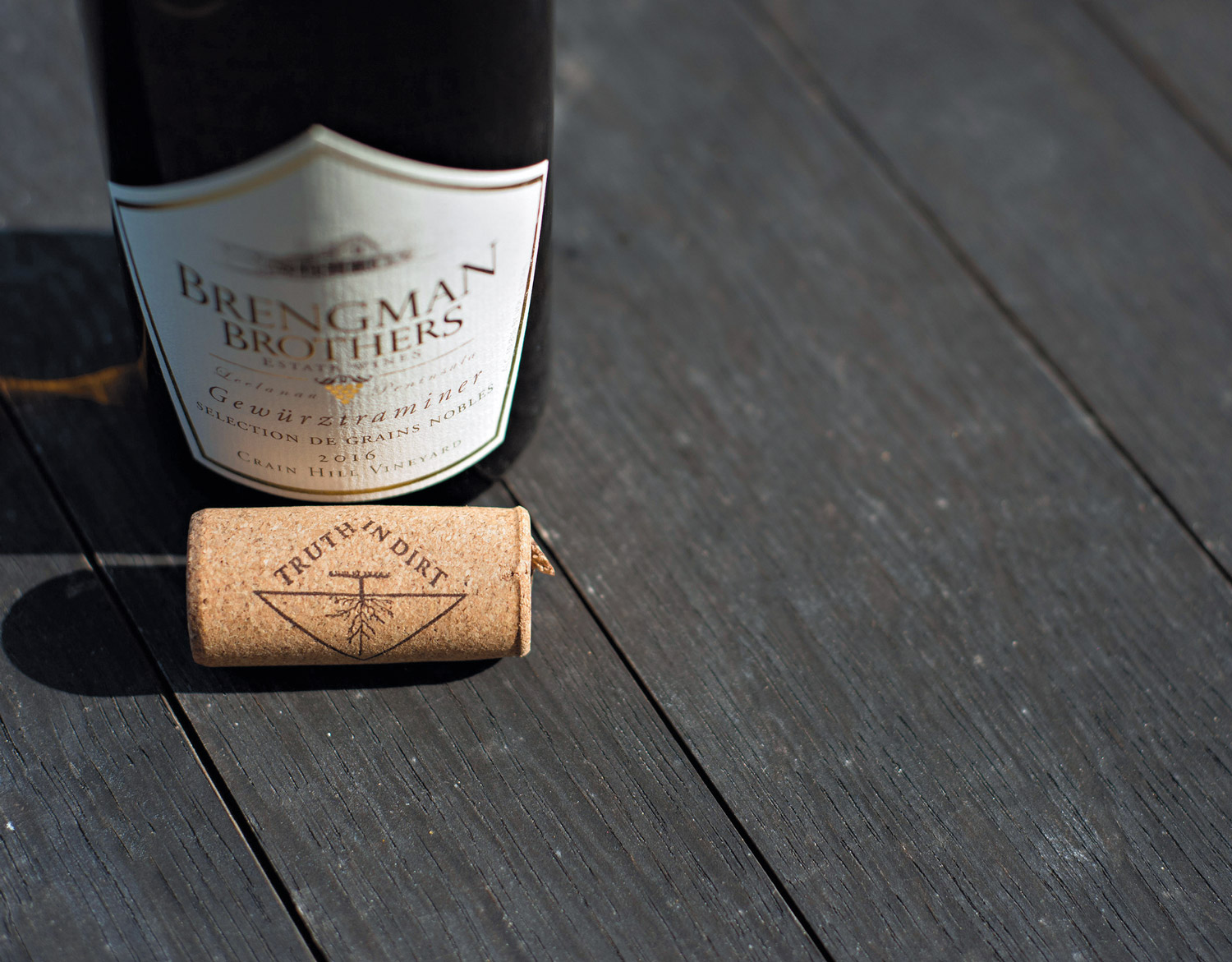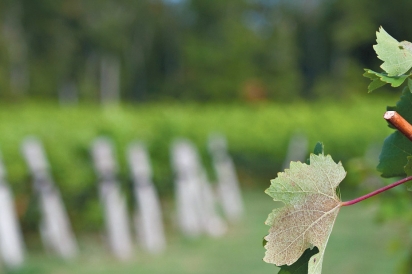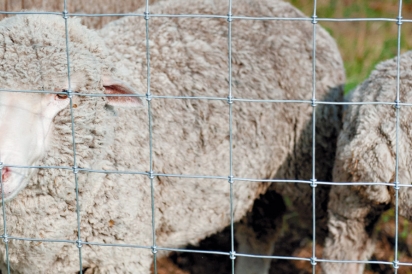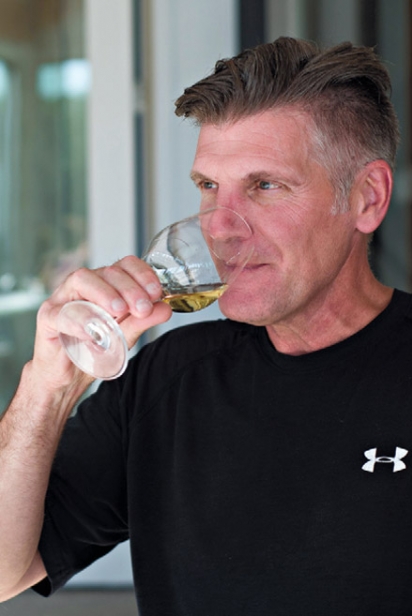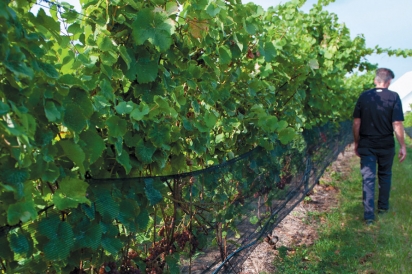In Praise of Sun, Dirt and Noble Rot
During the devastating winter of 2014–15 in Northwest Michigan, record-breaking cold froze the lakes and stopped budding grapevines in their tracks. But the following year, Mother Nature redeemed herself to winemakers with an unexpected gift.
Across the entire spectrum, 2016 was a year of surprises: The Cubs won the World Series for the first time in 108 years. And a relatively young vineyard on the Leelanau Peninsula produced what has been deemed a “historic” vintage. But if Robert Brengman, co-owner of Brengman Brothers Winery, had continued on his original career path, while he might have been creating wine bottle labels as he does now, they would not have been for his own vintages, nor would he be gathering accolades for his world-class Rieslings and Gewürztraminers.
ALL IN THE FAMILY
Brengman comes from a large, third-generation hospitality family from the Detroit area. His parents owned four restaurants on the northeast side of Detroit at one time.
“We were 13 siblings, so they had plenty of mouths to feed and bodies to put to work—all of us were involved in the business,” he says. But the restaurant field was not his passion. “I was talented in drawing and painting, and I wanted to become a graphic designer, so I enrolled in the College for Creative Studies in Detroit to study art and design. After getting my degree, I worked around Detroit for a few years, and then, in 1989, I thought I’d come up here and try to find a job in my field in Traverse City.”
The job hunt was successful, and he and his wife, Joni, settled into their new life up north. And then, in 2001, his brother Ed, who lived downstate, decided to buy some property in this area as an investment. “He asked me if I could start looking around for him,” says Brengman, “and we started talking about what kind of property—what kind of investment to focus on. Our Uncle Tom Sheuerman has the Seventh Hill Farms vineyard here, and when Ed came up to visit, we went over to check out his operation. Unexpectedly, he gave the two of us quite an education about what he was doing and about world-class fruit growing and the fact that it can be done here. That was the catalyst that got us thinking, ‘Why don’t we invest in property that we could turn into a vineyard?’”
Because of their family’s restaurants, the brothers had been around wine early on and developed a keen interest in it. “Both Ed and I were always researching,” says Brengman. “It was just wine at first, and then viticulture. And that was long before we ever thought of having a vineyard or a winery. When we did take the leap all those years later, we realized that one of the reasons we had wanted to do this was to produce the kind and style of wines that we ourselves like to drink. Our palates had always been more tuned in to Old World wines. So it was a combination of learning that you can grow superlative fruit up here—with whites, we can compete with some of the best regions in the world—and the fact that it was a challenge and an opportunity.”
And as luck would have it, their timing was right. The wine industry in this region was exploding.
TRUTH IN DIRT: GOING FOR THE GRAND CRUS
“Ed and I had learned a lot about what it takes to grow grapes in this region before we decided to buy,” says Brengman, “so when we were doing our property search, we were able to narrow it down quite a bit. We knew we wanted to be up high, in a place with good drainage and the right sun exposure.” They finally found what they now refer to as a Grand Cru location in 2003—a piece of land in Leelanau Country at the intersection of Center Highway and Crain Hill Road (which gave the new planting site its name: Crain Hill Vineyards—the winery and tasting room, which goes by Brengman Brothers, came later).
“When we came upon this parcel, every indication was that it would be perfect,” says Brengman. There is only about ten percent of the land on the Leelanau Peninsula and Old Mission Peninsula that is really ideal for Grand Cru growing— producing wines of the most superior quality We did all the soil testing—even soil tasting, believe it or not. Our slogan is “truth in dirt.” We focus on the soil and the orientation of the vineyard, and the fact that if you do things right, and the weather cooperates, you get outstanding wines.”
Brengman says there were early indications that 2016 was going to be a historic year for Riesling, as well as for Gewürztraminer. “We already knew it when we were tasting the grapes out on the vines, before we even crushed them and bottled them. The progress of the grapes had been two to three weeks ahead of our normal schedule all summer. And in late September, toward the end of the season, we could tell we had a good six weeks left before we’d have to harvest, so we decided to carry it through. I remember in November, we were picking in shorts and T-shirts on some of those days!”
Although it seems to have been mostly the weather that provided the historic 2016 vintage, factors such as the tending of the vines and the winemaking process all have an effect on the final product as well. “When you’re delivering wonderful fruit, you’re expecting wonderful wine at the end of that,” says Brengman. “So you’ve got to put a team together that’s going to be able to perform when Mother Nature gives you that gift. And we’re lucky to have our son Matthew as our vineyard manager and Margaret Thompson as our winemaker. Margaret came to us from California, where she got her oenology degree at Cal Poly, but she is originally from Midland. While she was in school, she was our intern in the summers, and then when she finished, we asked her to come on board full time.” She didn’t get in on the making of the 2016 vintage, but Brengman says 2017 could turn out to be another record harvest…
AS GOOD AS IT GETS
We’re sitting at a table in the glassed in, sun-filled private tasting room of the modern winery building that overlooks the vines when Brengman gets up and says, “I’ll be right back.” He returns soon afterward with a wine list and three tall, slender bottles that are instantly recognizable as the traditional shapes for Riesling and Gewürztraminer.
“I’m going to open this one first” he says, pointing to the list. “It’s from the first set of grapes we picked from our block in 2016, and it made a Spätlese level.”[See sidebar “What’s in a Name?” for more on Riesling classifications.] He pulls out a corkscrew, and it squeaks enticingly as it gently lifts the cork out of the bottle, culminating in that lovely “pop.” Then comes the familiar gurgling sound as he pours the straw-colored liquid into the glasses.
He swirls his own glass and sniffs: “Peach, stone fruit.”[Taking a sip] “Oh, now it’s just switched—there are some honey notes on the nose now—it’s warmed up a little bit. You know, it’s still a young wine, and it’s just getting over its bottle shock.” [Sniffs again] “That fragrance—it’s got petals on the nose—not the fruit itself, but like a peach blossom, elegant and smooth. And the minerality is coming out, especially on the end. It’s beautifully balanced. It just cleans the palate and just makes it delicious and easy to drink.
“That’s one of the nice things about the Riesling grape—it contains a lot of acid, and if it’s planted in the right spot, and you can hang it for a long time, and not ripen it too quickly, it will give you all of that— great sugars, great flavors, great acids. This wine has it all. When the season gives it to us, we’ll make it every year.”
The Beerenauslese Riesling is uncorked and poured with similar ceremony after the Spätlese, tasting like nectar from the gods. And finally, the 2016 Gewürztraminer, whose Noble Rot (the botrytis fungus— despite the scary name, it’s actually a desirable condition) earned it the coveted SGN (Sélection de Grains Noble) designation for its rich, concentrated flavor.
After a first sniff, swirl and sip Brengman leans back and says, “Isn’t it amazing? It’s got the citrus—it’s almost orange peel that’s on there—but it’s also got the lychee nut. It’s all tropical fruit. It definitely has the Gewürz buzz going on. Oh my gosh, the nose on it … there’s caramel—it’s showing so much.” For one who is partial to dry whites, he is totally appreciating this sweeter wine, too.
He shakes his head slowly. “Oh, but when they’re this focused, how could you not? I mean, even just this small amount of it is perfect, and to be able to spend an hour with this glass, with good company and good conversation, there’s no other place I’d rather be. Sometimes I’m asked, ‘Why are you doing this? Every morning I come to work, and the time I spend here is more like a vacation than a vocation. In the time span that we get to be here and care for this land and these plants, we are happy to be its stewards. Hopefully, we’ll start a tradition, and future generations will care for it after we are gone.”
IF YOU GO:
Brengman Brothers Tasting Room
9720 S. Center Highway, Traverse City
Open every day through December, check for hours.
BrengmanBrothers.com • 231-421-5611
What’s in a Name?
“We put the German words for the different style classifications on our Riesling wine labels, because for us, it’s just more accurate,” says Robert Brengman. “To use those names in Germany, you have to follow certain rules. You have to pick the grapes at a certain time, and the wine has to have a certain chemistry setup. Trocken [dry] is the driest, then Kabinett [off-dry], and then Spätlese [late harvest]. If you go up the sweetness scale from Spätlese, it would be an Auslese (select harvest), and from there it’s a big jump to Beerenauslese (berry select harvest) or Trockenbeerenauslese (dry berry select harvest). At the top of the scale is Eiswein (ice wine). We started putting those designations on the labels in 2013, because to us, the English versions didn’t mean anything. What is semi-sweet? What is medium-dry? We weren’t comfortable with it. So we adopted the German names. They don’t represent a place, but a style, so I don’t think we’re breaking any laws. And they make it easier for us to educate people about Riesling.”
Balance in All Things
It is generally said that the best wines are “well balanced.” That’s a non-scientific term, but it usually refers to harmony— harmony between factors such as acidity, tannins, sweetness, fruit and alcohol. But Brengman Brothers takes it a few steps further. “Design matters, too,” says Robert Brengman. “From our architecture to our landscaping to the layout at the end post, it all needs to be in harmony. It’s our duty to pay homage to this site, which we are so lucky to have.” As an extension of that respect for the land, Brengman Brothers has also made ecological balance a high priority. “It’s a matter of combining the best of ancient traditional viticulture with proven modern techniques,” he says.
In one example, Brengman believes that his winery might have pioneered the idea of moveable tanks. “It’s easy to ‘plug into the grid’ and take the energy that’s given to you and just keep increasing it,” he says, “but if you stop and think about what you’re doing with that energy… In our case, we were running a chiller to cold-stabilize our wine during the winemaking process. And at one point we said to ourselves, ‘Wait, we’ve got a lot of ‘free’ cold air here in February and March, and that’s right when we need it.’ So when we see that it’s going down to 10 degrees for a week, we can push our tanks manually out onto the crush pad for the time the wine needs to stabilize.”
Visitors to the winery are fascinated by the three solar panels along the driveway that winds up through the vineyards to the tasting room. “We’re in our fifth year with those panels, and it’s amazing,” he says. “The first two years before we had our full cellar laid out, we were getting all of our power from them. But then we added more equipment, and now we’re probably going to need another one in order to go back to zero net. But they collect, they work—and in our seventh year, the investment will be paid off.”
And then there is the matter of managing pests and diseases in the vineyard. “We knew that from the start that we wanted to do this as carefully as possible,” says Brengman. “Our building is right in the middle of the vineyard. So we’re very particular. We don’t use insecticides; we only use fungicides. We have guinea hens for insect control. And we’re raising sheep. When we’re done picking, we let them go through the vines, and they clean up the rest and eat for a while until it snows.” The animals’ natural fertilizer is then used for compost. “It’s all about striving to achieve better overall harmony with nature,” says Brengman. “We’re not inventing these practices, we’re just emulating them.”
A Perfect Pair(ing)
Rieslings and Gewürztraminers are the ultimate food wines. And those who think whites are only for drinking in the summer, take note: These lush whites can be enjoyed in any season. For the upcoming holidays, either would be a perfect match for turkey. Trocken Riesling pairs very well with oysters or shellfish. The dessert wine Beerenauslese begs to be served alongside a pear or apple tart. And that’s just scratching the surface. Check out the events page on Brengman Brothers’ website (BrengmanBrothers.com) for opportunities to experience more food pairings at the winery. After the holidays, they will be hosting regular “oyster socials” and library wine dinners throughout the winter.


